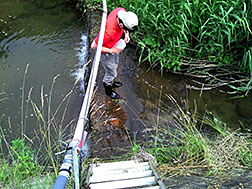- Number 452 |
- November 16, 2015
SRNL joins with Japan on new Fukushima research

Water sampling in the Kami-Oguni area
in Fukushima.
Researchers at DOE's Savannah River National Laboratory are collaborating with scientists in Japan to help find ways to remediate environmental areas contaminated by the Fukushima disaster. As part of this effort, they also hope to learn more about how radionuclides migrate through the environment to improve our ability to more accurately predict risk associated by radiological releases. The three-year joint project will focus primarily on the movement of plutonium and radioiodine.
“The Fukushima area provides a rare real-life glimpse of how radionuclides move through the environment. We intend to learn as much as possible from this tragic accident so that the U.S. and the international community are better prepared to deal with such accidents,” explained SRNL Senior Fellow Dr. Daniel Kaplan. “This research will help predict the risk associated with accidental radionuclide releases and will provide direction for long-term remediation or stewardship of contaminated environments.”
The project will involve extensive laboratory testing conducted in the U.S. and Japan and will result in a model that could be used universally to predict the fate and transport of radioiodine and plutonium. Many of the researchers have collaborated on previous projects in both countries. The U.S. team is led by Kaplan and Dr. Peter Santschi from Texas A&M University and is funded through the Department of Energy’s Office of Science, Office of Biological and Environmental Research. The Japanese team is funded through multiple Japanese sources.
The U.S. team was selected based on research experience dealing with radionuclides at the Savannah River Site and at the Hanford Site in Washington. The Japanese researchers are world experts on the radiological releases from the Fukushima accident and have extensive access to the study site. “This project scope could not be completed by scientists from either individual country,” said Kaplan.[Will Callicott, 803.725.3786,
will.callicott@srnl.doe.gov]
